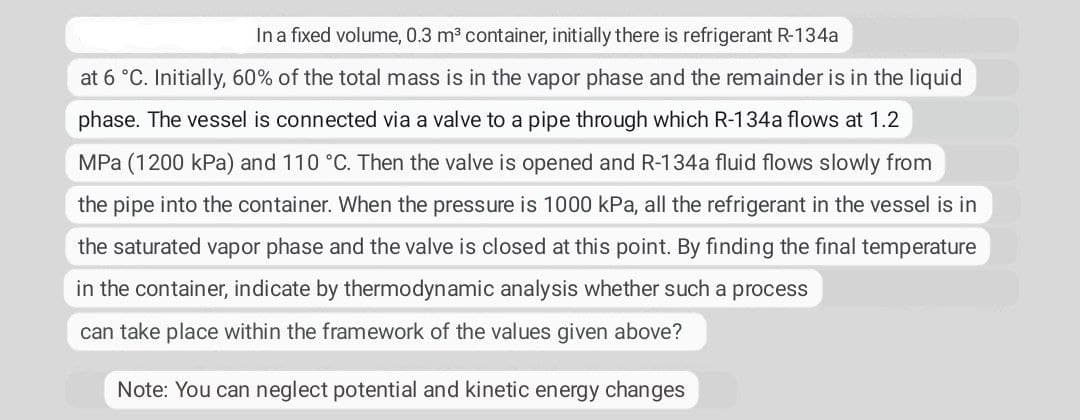In a fixed volume, 0.3 m³ container, initially there is refrigerant R-134a at 6 °C. Initially, 60% of the total mass is in the vapor phase and the remainder is in the liquid phase. The vessel is connected via a valve to a pipe through which R-134a flows at 1.2 MPa (1200 kPa) and 110 °C. Then the valve is opened and R-134a fluid flows slowly from the pipe into the container. When the pressure is 1000 kPa, all the refrigerant in the vessel is in the saturated vapor phase and the valve is closed at this point. By finding the final temperature in the container, indicate by thermodynamic analysis whether such a process can take place within the framework of the values given above?
In a fixed volume, 0.3 m³ container, initially there is refrigerant R-134a at 6 °C. Initially, 60% of the total mass is in the vapor phase and the remainder is in the liquid phase. The vessel is connected via a valve to a pipe through which R-134a flows at 1.2 MPa (1200 kPa) and 110 °C. Then the valve is opened and R-134a fluid flows slowly from the pipe into the container. When the pressure is 1000 kPa, all the refrigerant in the vessel is in the saturated vapor phase and the valve is closed at this point. By finding the final temperature in the container, indicate by thermodynamic analysis whether such a process can take place within the framework of the values given above?
Elements Of Electromagnetics
7th Edition
ISBN:9780190698614
Author:Sadiku, Matthew N. O.
Publisher:Sadiku, Matthew N. O.
ChapterMA: Math Assessment
Section: Chapter Questions
Problem 1.1MA
Related questions
Question
I need helpe in THERMODYNAMICS please.

Transcribed Image Text:In a fixed volume, 0.3 m³ container, initially there is refrigerant R-134a
at 6 °C. Initially, 60% of the total mass is in the vapor phase and the remainder is in the liquid
phase. The vessel is connected via a valve to a pipe through which R-134a flows at 1.2
MPa (1200 kPa) and 110 °C. Then the valve is opened and R-134a fluid flows slowly from
the pipe into the container. When the pressure is 1000 kPa, all the refrigerant in the vessel is in
the saturated vapor phase and the valve is closed at this point. By finding the final temperature
in the container, indicate by thermodynamic analysis whether such a process
can take place within the framework of the values given above?
Note: You can neglect potential and kinetic energy changes
Expert Solution
This question has been solved!
Explore an expertly crafted, step-by-step solution for a thorough understanding of key concepts.
Step by step
Solved in 4 steps with 3 images

Knowledge Booster
Learn more about
Need a deep-dive on the concept behind this application? Look no further. Learn more about this topic, mechanical-engineering and related others by exploring similar questions and additional content below.Recommended textbooks for you

Elements Of Electromagnetics
Mechanical Engineering
ISBN:
9780190698614
Author:
Sadiku, Matthew N. O.
Publisher:
Oxford University Press

Mechanics of Materials (10th Edition)
Mechanical Engineering
ISBN:
9780134319650
Author:
Russell C. Hibbeler
Publisher:
PEARSON

Thermodynamics: An Engineering Approach
Mechanical Engineering
ISBN:
9781259822674
Author:
Yunus A. Cengel Dr., Michael A. Boles
Publisher:
McGraw-Hill Education

Elements Of Electromagnetics
Mechanical Engineering
ISBN:
9780190698614
Author:
Sadiku, Matthew N. O.
Publisher:
Oxford University Press

Mechanics of Materials (10th Edition)
Mechanical Engineering
ISBN:
9780134319650
Author:
Russell C. Hibbeler
Publisher:
PEARSON

Thermodynamics: An Engineering Approach
Mechanical Engineering
ISBN:
9781259822674
Author:
Yunus A. Cengel Dr., Michael A. Boles
Publisher:
McGraw-Hill Education

Control Systems Engineering
Mechanical Engineering
ISBN:
9781118170519
Author:
Norman S. Nise
Publisher:
WILEY

Mechanics of Materials (MindTap Course List)
Mechanical Engineering
ISBN:
9781337093347
Author:
Barry J. Goodno, James M. Gere
Publisher:
Cengage Learning

Engineering Mechanics: Statics
Mechanical Engineering
ISBN:
9781118807330
Author:
James L. Meriam, L. G. Kraige, J. N. Bolton
Publisher:
WILEY